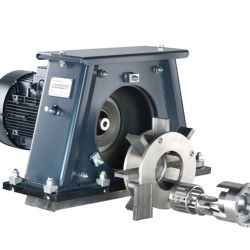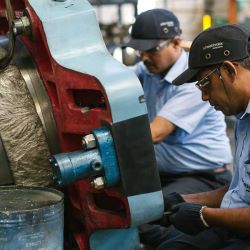Selecting the correct abrasive medium for cleaning and peening surfaces is crucial to achieve the desired surface finish, but the process can be both complex and confusing.
The list of blast media options can be quickly narrowed down by recognising the equipment available for the process. For example, glass beads would not work in a wheelblast machine as they would shatter immediately.
Cleaning or peening?
The next question is an obvious, yet crucial, one that can further narrow down the list of suitable abrasives: what are you trying to achieve and what is the desired surface finish?
Although the list of available abrasives is long, they generally fall into two distinct classes:
Eroding materials are randomly-shaped angular particles that are designed to cut and erode the component, mainly for the purposes of cleaning and/or decontaminating a surface.
Peening abrasives are nearly always round in shape and are designed to knock or compress the surface, leaving it both clean and dimpled. The shot peening process is specifically designed to enhance the fatigue strength of components which are subject to high alternating stress – such as the wing of an aircraft.
Abrasive types
Here’s a quick rundown of commonly used abrasive types and their applications:
Fused Alumina
Available in three pure qualities, this synthetic abrasive is renowned for its hardness, toughness and sharpness, making it a very aggressive material which will leave a matt etched surface.
- White fused alumina
With sharp and irregular particles, white fused alumina is well suited for processing hard surfaces such as carbides and hardened steel, and for applications where no contamination is tolerated. Its high purity also allows it to be used on high-precision electrical components. However, its sharpness is also its downfall, and abrasive life is sacrificed for purity.
- Brown fused alumina
Brown alumina is less pure than its white counterpart, giving it extra toughness and a longer life, therefore making it more economical. In its purest form, the material is frequently used in the aerospace industry, typically to remove residual coatings and prepare surfaces before coating.
- Pink fused alumina
Pink alumina was developed to incorporate the toughness of brown and combined with the purity of white alumina. It is sharp and fast cutting, making it ideal for applications where no contamination is tolerated.
Metallic abrasives
This group of materials includes steel shot and grit, cast iron grit, high tensile cut wire, stainless steel shot and aluminium shot. While highly effective for peening, an important factor to consider is the potential for surface contamination from the blast media – which could occur when using a steel shot to peen a stainless steel surface.
It is also important to remember that, due to their density, most metallic abrasives will cause considerable wear to both wheel and air blast equipment.
Plastics
Plastic abrasives are angular in shape, but do not etch the surface due to their relative softness. They are designed to deform on impact and clean the coating without damaging the surface.
Glass/ceramic beads
Glass and ceramic beads are mainly designed to clean surfaces, producing a satin surface finish with minimal stock removal or surface damage. Being completely iron and lead free, they are able to process non-ferrous components without contamination.
Process parameters
Choosing the correct abrasive is certainly an important step, but the job doesn’t end there. All too often the abrasive medium is blamed for poor processing, when it is in fact the machine set-up or the operating controls which are at fault.
Poor performance can be associated with many things including unsuitable air pressure, the settings of the cyclone and dust extractor or even worn machine components. However, it is difficult to give general operating parameters as abrasives used for blasting processes behave and break down in different ways.
Advice: consider the whole process and all relevant parameters when looking for the cause of bad blast performance.
Importance of maintenance
Most abrasives are only economical if they are recirculated and reused, and the majority of machines have air or mechanical methods of removing broken down media from the abrasive. The machine must be kept topped up with good media, and the user must ensure that broken down dust and debris from the components is removed from the system.
Topping up the media should be done on a little but often basis, as this will keep the abrasive in good order and ensure consistent blast results.
If you need advise on your abrasive blast media, contact Wheelabrator here.


